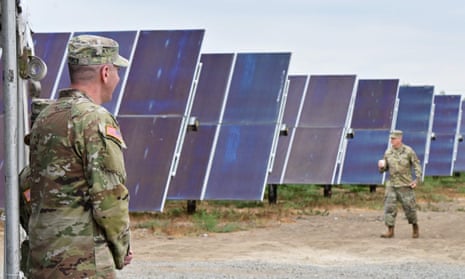Plumes of toxic PFAS “forever chemicals” flowing from at least 245 US military bases are contaminating or threatening to pollute drinking water for nearby communities, and hundreds more are likely at risk across America, a new Department of Defense report finds.
The number of communities threatened by the military’s pollution is likely to increase as further more investigations are carried out. The defense department has only looked at about one-third of more than 700 facilities suspected of having contaminated the ground with PFAS.
While the report acknowledges the pollution, it does not clarify which drinking water sources are polluted, how high PFAS levels are in the polluted water systems, or provide information about the plumes’ locations.
The sheer number of bases and the lack of clarity is “shocking”, said Scott Faber, the vice-president of government affairs at the Environmental Working Group non-profit, which tracks military PFAS pollution.
“A good neighbor would let you know that their use of PFAS was the reason your water was contaminated, and a bad neighbor would only tell you: ‘Hey, a plume is heading in your direction,’” Faber said.
The defense department did not immediately respond to a request for comment.
PFAS, or per- and polyfluoroalkyl substances, are a class of about 15,000 compounds most frequently used to make products water-, stain- and grease-resistant. They have been linked to cancer, birth defects, decreased immunity, high cholesterol, kidney disease and a range of other serious health problems.
They are dubbed “forever chemicals” because most do not degrade in the environment.
The military is considered one of the largest PFAS polluters in the world, largely due to its use of firefighting foam laced with the chemicals discharged during emergencies or training exercises. Some of the highest levels of PFAS in groundwater ever detected have been found around bases. The Environmental Protection Agency’s advisory health guidelines state that less than one part per trillion (ppt) in drinking water is safe, while levels found around military bases have exceeded 2.25m ppt.
Congress in recent years has included in Defense Authorization Acts requirements for the military to begin investigating PFAS pollution in and around its facilities. The defense department has so far confirmed PFAS contamination at 455 bases, it wrote in the new report, and of that group it has confirmed that 275 out of 295 checked, or about 90%, have plumes “in the proximity” of drinking water supplies.
The report does not clarify what “in the proximity” means and does not specify which types of drinking water supplies are threatened. Though it provides a list of bases, public drinking water systems can draw from surface water or community wells, and it is unclear how the plumes may be impacting those pulling water from private wells.
“That is what we know so far because that’s all the DoD told us, and it took an act of Congress to get that much information,” Faber said.
Though the report does not provide clarity on which communities are drinking contaminated water, the defense department in August issued a separate report revealing that it is now providing clean drinking water to 53 communities.
The military currently only provides clean drinking water for communities with levels of PFOA and PFOS, two kinds of PFAS compounds, above 70 ppt. The EPA is proposing lowering the legal limit to 4 ppt. If it does, as expected, the defense department will likely be forced to provide drinking water to most, if not all, communities around facilities where there is PFAS contamination.
Even as the military uncovers more PFAS pollution in and around its sites, the amount of spending on remediation of all pollution at its bases is dropping.
“Communities around the facilities must be really frustrated because they in all likelihood are drinking from wells that are contaminated by the military, but the DoD is coming up short,” Faber said. “Inevitably we will get answers for these questions as we move through the process.”
